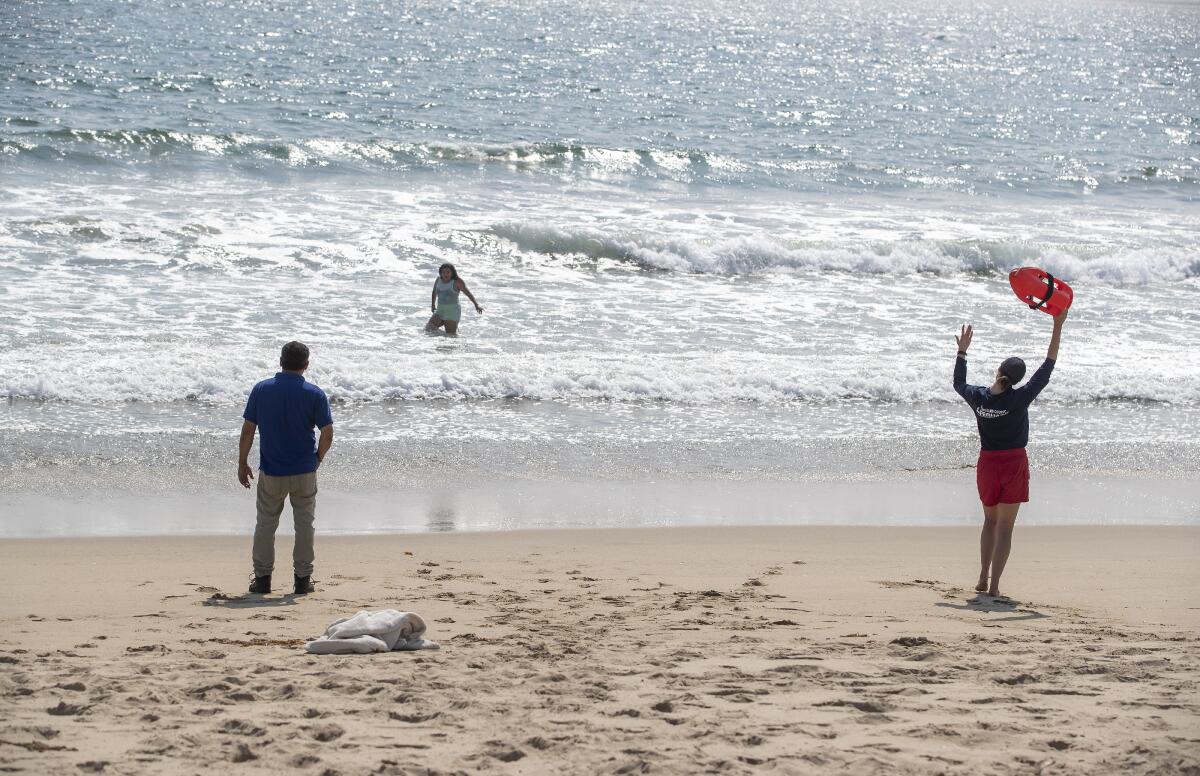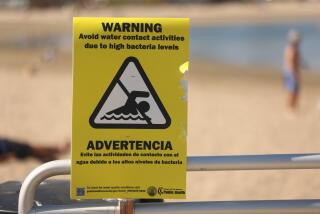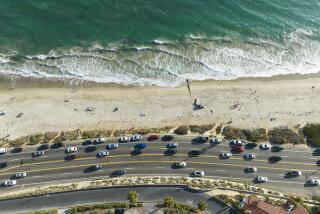Long delay in alerting public to massive beach sewage spill raises alarm

- Share via
After 17 million gallons of raw sewage were discharged into the ocean off Los Angeles beaches early Monday, county officials waited hours before notifying the public to avoid swimming in areas potentially affected by high levels of bacteria.
The delay occurred even though officials from the Los Angeles County Department of Public Health, which is responsible for notifying the public, were at the Hyperion Water Reclamation Plant in Playa del Rey during the emergency discharge procedure that began Sunday evening and ended Monday around 4:30 a.m., according to interviews.
Public health officials posted a beach closure advisory on their website urging residents to avoid swimming at Dockweiler and El Segundo beaches and shared the notification on Twitter at 5:30 p.m. Monday.
Officials and environmental experts said such delays put the public at risk, and the county needs to improve its protocols for notification and testing.
“A press release posted on the L.A. County Department of Public Health webpage is not good enough,” said Shelley Luce, president and chief executive of Heal the Bay. County officials should have begun informing the public early Monday via social media, she said, adding, “It’s time for a better protocol.”
Julio Rodriguez, a captain with the county Fire Department Lifeguard Division at Dockweiler Beach, told The Times his crews found out about the beach closure around noon — after seeing a county worker posting a sign on a lifeguard tower.
“That’s how we received official notification of the closure of the beaches,” he said.
After seeing the sign, Rodriguez said, lifeguards began warning beachgoers to stay out of the water.
Los Angeles County Supervisor Janice Hahn said Tuesday that she was seeking answers from county health officials and the city, which operates the Hyperion Water Reclamation Plant.
“What happened yesterday was unacceptable and irresponsible,” Hahn said in a statement. “We need answers from L.A. City Sanitation about what went wrong and led to this massive spill, but we also need to recognize that L.A. County Public Health did not effectively communicate with the public and could have put swimmers in danger.”
Timeyin Dafeta, executive plant manager at the Hyperion Water Reclamation Plant, said an investigation was ongoing, but his crews had ruled out human error or mechanical failures.
He said construction materials, including wood chips and pieces of concrete, along with paper and grease, clogged the filtering screens. The materials were either flushed down a toilet or dumped in a maintenance hole somewhere along the city’s 6,700 miles of sewage pipes, he said.
“Those things should not be in our system,” Dafeta said. “That, in essence, is what caused the whole thing.”
He said crews tried replacing the screens and diverting water but were forced to begin discharging the sewage through the emergency pipe around 7:30 p.m. Sunday to avoid a “catastrophic situation.”
Plant crews alerted the state Office of Emergency Services at 8:10 p.m., and the state notified the county Department of Public Health, which sent officials to the plant, according to Dafeta.
Brett Morrow, a spokesman for the Department of Public Health, said in an email at 9:25 p.m. Tuesday that state officials alerted the agency about the spill at 8:11 p.m. Sunday and that inspectors arrived at the plant at 10:36 p.m.
He said officials at the Hyperion plant confirmed around 10 a.m. Monday morning that 17 million gallons of untreated sewage had been discharged and county health officials began posting signs at the beaches by 11 a.m.
Morrow said water testing was conducted Monday morning, at the discharge area and at beaches seven miles north and seven miles south of the incident. Tuesday results showed each sample was found to be within state standards for acceptable water quality, Morrow said. If state standards are met again Wednesday, the beaches will reopen on Thursday, Morrow said.
“We are evaluating our response to this incident and will update our practices going forward to ensure that measures are in place to effectively notify the public,” Morrow said.
The 17 million gallons — which represent about 6% of the facility’s daily load — amounted to the largest emergency discharge conducted at the Hyperion plant in a decade, officials said. The plant, which began operating in the 1920s, is the city’s oldest and largest wastewater treatment facility.
During the hours-long operation, crews directed the sewage through a 1-mile pipe that ends 50 feet under the water, Dafeta said. The plant normally discharges wastewater 190 feet down, using a 5-mile pipe.
Luce of Heal the Bay said county officials should develop a process that uses computer modeling based on real-time current, wind and swell data to predict the direction of spread for contaminants that spill or are discharged into the ocean.
With real-time data, she said, “we can predict how bacteria will move.”
Similar technology is used by Heal the Bay to determine the water quality at beaches and by surfers to predict the size and direction of waves.
“With a spill this size, they should have closed the nearest beaches sooner,” Luce said. “A mile offshore is too close for 17 million gallons of sewage.”
At Dockweiler Tuesday, the beach was empty, aside from a few people walking along the shore or relaxing in lawn chairs. Signs staked into the ground announced that the water was closed for swimming: “Contact with ocean water may cause illness.”
Several people said they had no idea the beach had been closed.
Suni Pradahn, 42, who was wearing headphones as she strolled on the sand, said she found out about the closure after she arrived at the beach.
“I was wondering what happened to the people. I didn’t see anyone in the water,” said Pradahn, who lives nearby in Playa del Rey. “I really don’t know what’s going on.”
More to Read
Sign up for Essential California
The most important California stories and recommendations in your inbox every morning.
You may occasionally receive promotional content from the Los Angeles Times.











